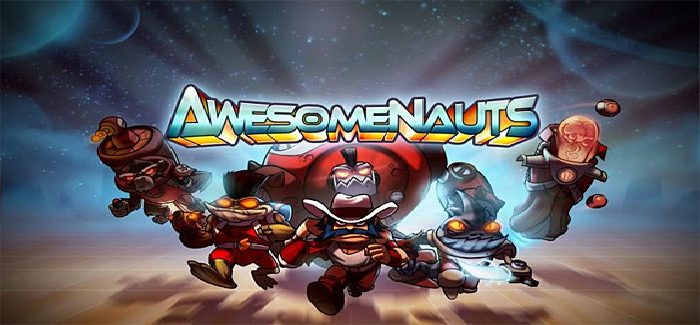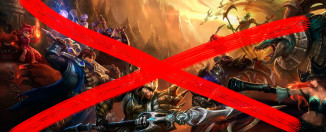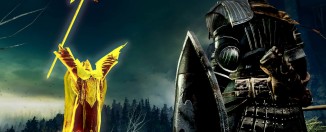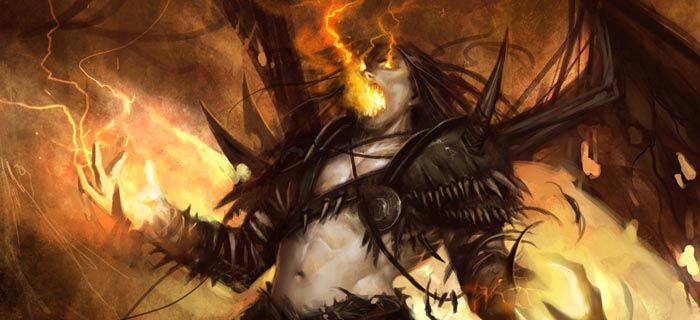The Awesomenauts review: Aim for the moon
Recently I had the opportunity to play through Romino Games’ Awesomenauts, a 2D DOTA-style game. I’m not much of a DOTA guy and never have been, so think of this review as being written from the perspective of a DOTA noob.
Part of the fun of playing and learning this game was realizing how the team dynamic operates and how cooperation is essential to victory, something that, as most readers here may know, is unfamiliar to me, being used to flying solo in games like SFIV.
Meet the Awesomenauts
The object of the game, like similar games such as DOTA or League of Legends is to destroy the enemies’ base. In order to do that you must first fight your way through two turrets that are very powerful and tough to take on alone, provided you even have the opportunity to take down a turret unabated by the opposing teams’ players. Of course, moving as a group and creating a team dynamic capable of taking down turrets while protecting your own and not getting ganked by your enemies is essential.
To that end, you have a choice between six different characters right now, and the promise of more in the future. There’s a cowboy, Lonestar, who specializes in crowd control, a stealthy chameleon named – *sigh* – Leon, Voltar, a mysterious alien who heals allies, the stylin’ Froggy G, Yuri, a Soviet jetpack monkey, and Clunk, a tank character. Each character is designed aptly and fills their own specific niche, allowing for a wide variety of team combinations that’ll dictate how your team fulfills the main objective successfully. You also gain levels by fighting and being a part of the chaos, and with each level you gain basic stats.
Every character has their own unique basic attack, movement properties, and special abilities, which can all be upgraded during each battle by spending in-game currency, Solar. Solar is gained by killing neutral grunts at locations in the middle of every map, other players, or the opposing teams’ AI-controlled reinforcements that march in a straight line down each lane. You can also pick it up off the ground from fixed locations which will respawn over time, providing a Solar advantage for anyone who knows the maps and respawn timing better.
Some of the abilities are highly useful, and almost necessary, like Froggy G’s splash which stuns enemies, or Leon’s stealth which renders him invisible to opponents. However, characters like Yuri have abilities that are a lot less effective and could probably use some enhancements. You can also use Solar to upgrade basic attributes like total health, damage, movement speed, and jumps, which are usually pretty solid choices that yield noticeable upgrades.
DOTA in space
Both teams feature three players that can either be three local or online players or any combination of players and bots. Games begin with your teams falling from rockets, which crash to the ground, releasing your character. On the way down you can steer your rocket and collect Solar which is scattered in several different patterns, which I found was an entertaining and creative means of collecting additional money for upgrades. This process of falling down from the rocket happens each time you die, complete with a few seconds of respawn time. While you can collect Solar on the way down that’ll make up for the Solar you lost being killed, make no mistake – having one teammate out of the battle for the period of time spent respawning and then walking back to the battle ensures that dying comes with a strict punishment.
Before each game, you pick your character, and then pick the abilities and upgrades that you would like to be available in your store during your next match. You have a choice of 3 out of 6 possible upgrades for each different ‘set’ of upgrades, and each character has 4 sets, each pertaining to basic attributes and then the characters’ basic attack and their two special abilities. However, 2 of the 6 upgrades you can choose from are locked and can only be unlocked by gaining ‘levels’ that stick to your gamertag. Each battle you gain experience and every time you level you unlock 1 skill for a character, but it takes up to level 40 to have everything unlocked – that is a lot of playtime for upgrading abilities, and can make it so that players who play the game often start with an advantage.
In addition to unlocking abilities, you also have to unlock Yuri, Voltar, and Clunk. This doesn’t take long – you only have to get to Level 11 to get Yuri, the last character, which is about 3 or 4 hours of playtime – but I could do without it. The main reason why is in the beginning it forces you to use Lonestar, Froggy G, and Leon, which, again, prevents you from playing different team compositions from the very get-go. This means that players who have played the game more than you coming into the game are going to have an advantage by playing team compositions that might counter your limited choices.
Don’t let the unlocks fool you
This is compounded by the games’ lack of direction. There is no campaign and what there is of it doesn’t introduce you to the importance of Solar or team composition – you merely play as Lonestar in a quick tutorial that explains what the objective of the game is, and as soon as you finish it, it encourages you to play online. At the time, I remember thinking – already? I expected at least the opportunity to get a feel-out mission with a couple of the other characters so I’d know what I was getting into when I went online, but that wasn’t the case. It took me a while to find my stride.
For those reasons, the beginnings of the game betray how fun the game can actually become once you figure out what’s going on. As soon as I unlocked Voltar and Clunk, I was beginning to figure out some efficient strategies and was doing some good work playing as Leon with a friend playing as Froggy G. We had a good strategy of burst offense and won a couple games, and then decided to move onto different teams to see what we could accomplish. Out of a bunch of different combinations, we had the most success with the healer-tank combo of Voltar and Clunk. With those two, you can form a huge ball along with your teams’ reinforcements and make commanding, unstoppable pushes.
More momentum-based gameplay
One of the aspects of this game that I’m not fond of is that as soon as you fall into a hole, you’re pretty much done. So many games were lost because my teammates and I didn’t get the first few levels off of the neutral grunts that spawn in the middle of every map, and as soon as our opponents became more powerful than us, we were hooped. Of course, a lot of the games that we took the lead early in were victories for us, and there is the potential for a comeback in every seemingly lost game, but that possibility seems remote. Too often there was a feeling of hopelessness.
Of course, that means that the beginning of the game is the most important moment of all. For better or for worse, the outcome of the game can usually be decided pretty quickly, which leads to some ‘lame duck’ games. This is compounded by the fact that usually when you join your first game of the day, you’re put into a game that is already underway. You’re rewarded with additional Solar to make up for the time past and a couple gimme levels, but if your team was behind at the beginning when you weren’t even there, you won’t have much of a chance to turn it around with low stats and Solar. One time I joined a game that ended the second I joined it – in addition to that, players coming and going during matches is not uncommon. In the event players leave, they become a bot, who, while not necessarily stupid, isn’t exactly a team player. Normally, the best way to play the game is to join the match and let it play out, then just remain in the same lobby and continually play your opponents, who are also probably staying in the same lobby.
That means random matchmaking is uncommon, and you’ll likely be playing the same team combination for a while unless you leave the game and wait a while before joining a new one. In fairness, these aren’t the pitfalls of the game itself, but rather a small online player base. Regardless, some additional fixes would be welcome – two on two doesn’t seem like an unfair alternative to three on three, which means a higher possibility of all-player games instead of bots, and having more lobbies that remain active longer so matches won’t start until all player slots are filled in. Playing with bots isn’t the worst thing in the world, but I’d prefer to play against, and with, other players.
Playing with lag can also be a frustrating experience. There’s a noticeable delay that becomes pretty frustrating, especially when you play Clunk. He has a self-destruct attack that, with his movement speed buff, becomes nigh-impossible to dodge on reaction, which basically forces you to grab a movement speed buff of your own just to have a chance of avoiding that heavy-damage attack. Having lag dictate your strategy is undesirable.
Should you play Awesomenauts?
Among all that, though, the game is undeniably fun and chaotic. The graphics are sharp, colorful, and simple, and the sound isn’t overly distracting. There are theme songs for each character but they aren’t very memorable, with the exception of Froggy G’s, a slick, smooth hip hop style that fits well with his character. The story is merely an explanation for the kind of characters and locations that are used in the game.
With some more characters, some balancing tweaks and a readjustment of the matchmaking system, Awesomenauts would be a strong multiplayer experience that is great for picking up and playing with groups of friends.
Right now, the experience isn’t quite as strong as it could be, but the game is fun and enjoyable regardless. I recommend playing with friends locally and playing online because playing on a team with bots is a dull, meandering experience. Feel free to share your experiences with Awesomenauts in the comments.








[…] Plane Games Reviewed Here – ONLINE PLANE GAMESGears of War 3 – Review (X360)Gears Of War 3The Awesomenauts review: Aim for the moon .skin #header_img { background: […]